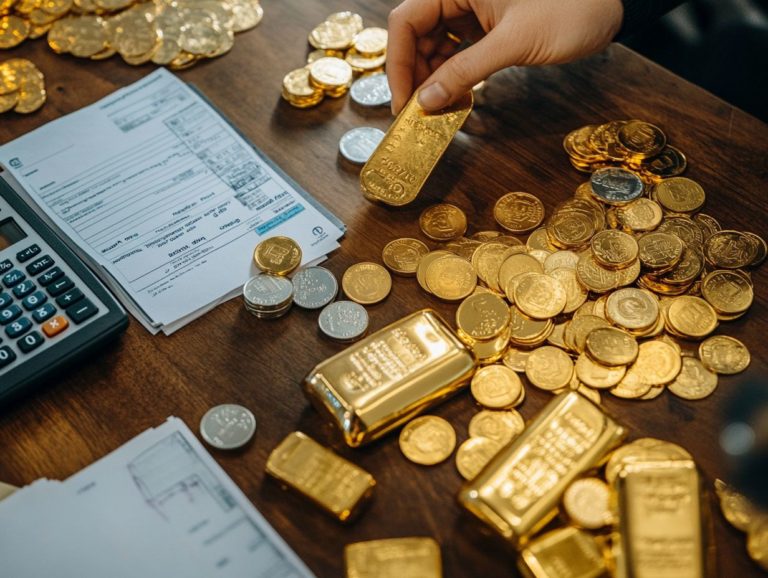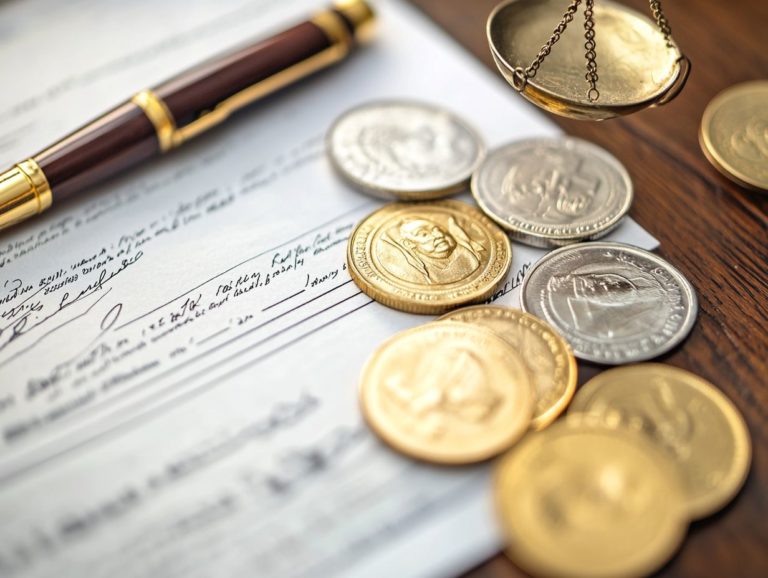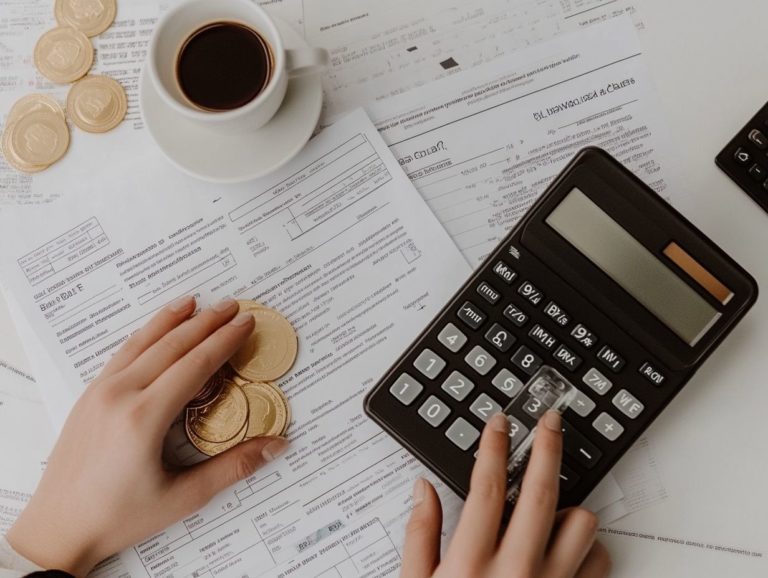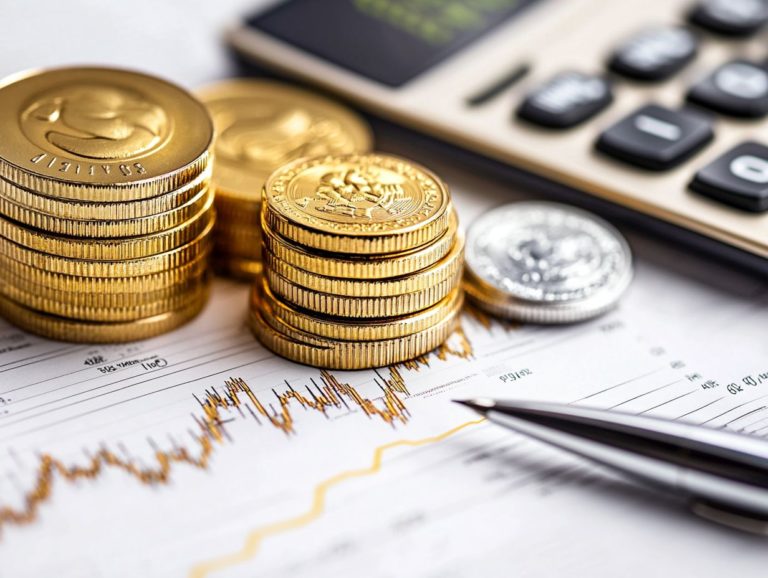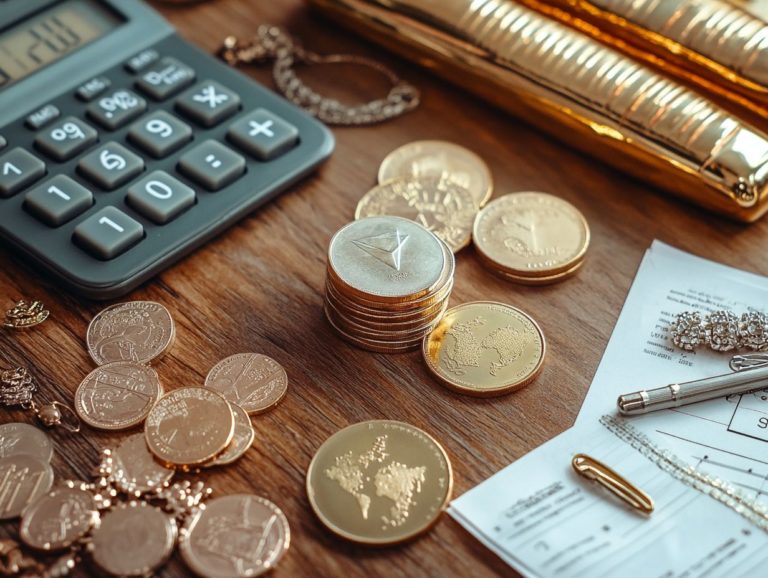The Tax Benefits of Precious Metals in Retirement Accounts
Investing in precious metals can be a savvy addition to your retirement strategy, providing unique benefits that traditional assets often overlook.
This article delves into the different types of retirement accounts that permit precious metals, ranging from IRAs to 401(k)s. It emphasizes noteworthy tax advantages, such as tax-deferred growth and tax-free distributions.
We also examine how you can invest in these assets, the potential risks involved, and essential considerations to keep in mind.
Explore the insights to discover how precious metals can enrich your financial future!
Contents
- Key Takeaways:
- Tax Benefits of Investing in Precious Metals in Retirement Accounts
- How to Invest in Precious Metals in Retirement Accounts
- Risks and Considerations
- Frequently Asked Questions
- What are the tax benefits of investing in precious metals within a retirement account?
- Are there any restrictions on investing in precious metals in retirement accounts?
- Can I rollover funds from my current retirement account into a precious metals IRA?
- Do I have to pay taxes when I withdraw precious metals from my retirement account?
- Are there any risks associated with investing in precious metals within a retirement account?
- What are the options for holding precious metals in a retirement account?
Key Takeaways:
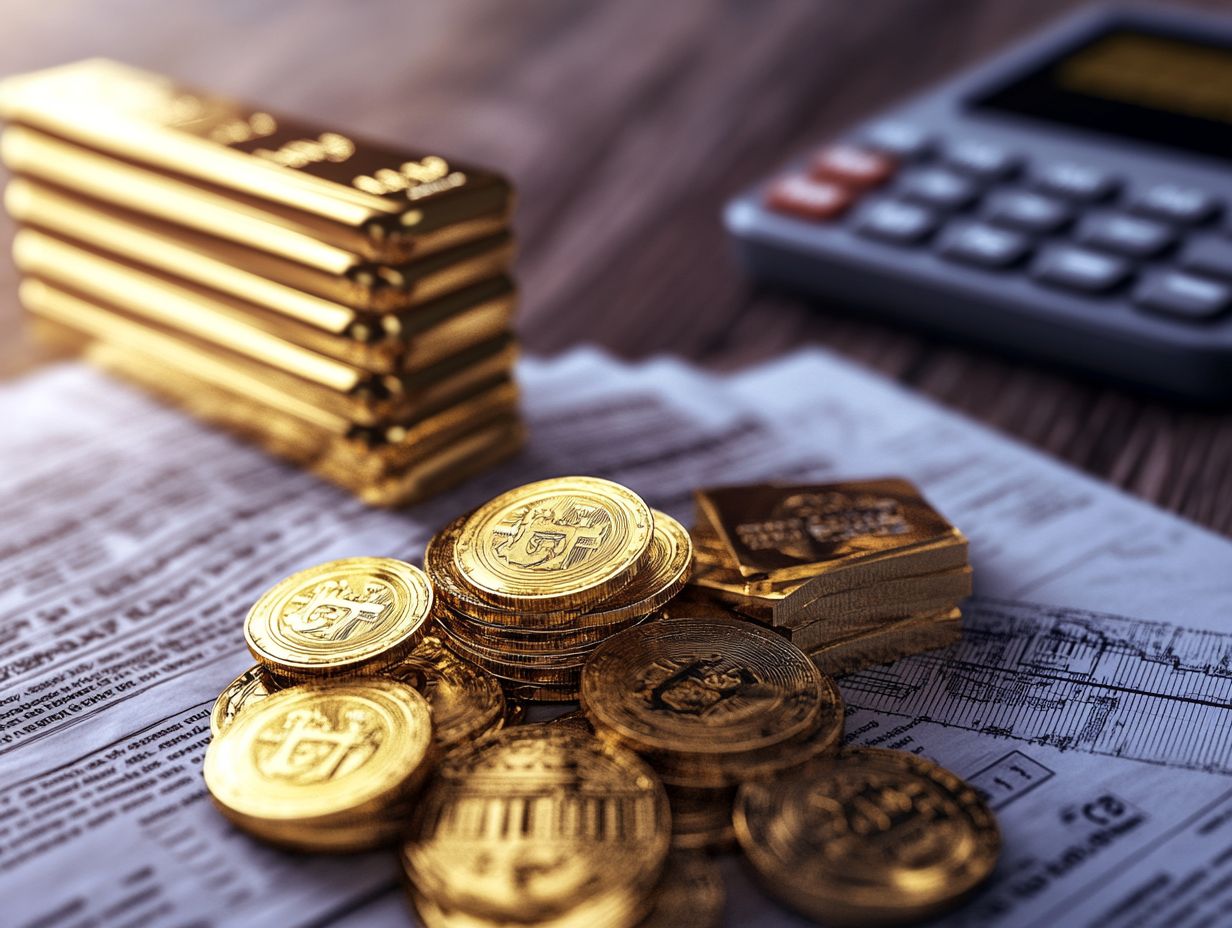
- Include precious metals like gold and silver in certain retirement accounts for potential tax benefits.
- Investing in precious metals within retirement accounts may allow for tax-deferred growth and tax-free distributions upon retirement.
- Understand the risks involved and carefully consider all factors before investing in precious metals for retirement.
What are Precious Metals?
Precious metals gold, silver, palladium, and platinum are valuable resources known for their value and stability, especially during economic uncertainty. Recognized as safe-haven investments, these metals act as a hedge against inflation and retain their worth across various market conditions.
Historically, these metals have been fundamental to economies around the world, acting as currency and the backbone of trade. Their versatility is unmatched, from exquisite jewelry to essential industrial applications. When economic turbulence strikes, many investors turn to precious metals as a reliable store of value, safeguarding wealth from market fluctuations.
As industries increasingly depend on these materials for technological progress, the demand for them continues to rise. Don’t miss out on how these metals can safeguard your wealth during tough market conditions! Precious metals not only symbolize luxury but also play an integral role in modern financial strategies, captivating interest for their aesthetic allure and critical utility.
Types of Retirement Accounts that Allow Precious Metals
Looking to boost your retirement? Here are account types that let you invest in precious metals! You’ll find several account types that enable you to incorporate precious metals into your portfolio, such as a gold IRA, self-directed IRA, traditional IRA, and Roth IRA.
These retirement accounts provide a distinct advantage by allowing you to diversify your retirement funds with physical assets like gold and silver, enhancing your wealth protection strategies. Additionally, it’s important for investors to understand tax brackets for precious metals investors to make informed decisions.
A gold IRA specifically focuses on investments in precious metals and serves as a robust hedge against inflation and economic instability. Meanwhile, a self-directed IRA is a retirement account that you manage yourself, granting you greater control over your assets and the freedom to select alternative investments, including real estate or commodities.
Traditional IRAs and Roth IRAs are conventional choices, each presenting unique tax benefits and contribution rules. Be aware of IRS regulations regarding the types of precious metals that qualify for inclusion and the requirement for custodial services, which may carry associated fees. To learn more, consider the role of precious metals in tax-advantaged accounts to understand these factors if you’re looking to leverage these accounts for safe-haven assets in the long run.
Tax Benefits of Investing in Precious Metals in Retirement Accounts
Investing in precious metals through your retirement accounts presents substantial tax benefits that can significantly boost the growth of your investment portfolio. By employing structures such as a gold IRA or self-directed IRA, you can enjoy tax-deferred growth, allowing you to defer taxes on gains until you take distributions.
This approach maximizes your wealth protection over time, enhancing your financial strategy for the future.
Ready to secure your financial future with precious metals? Start your journey today!
Tax-Deferred Growth
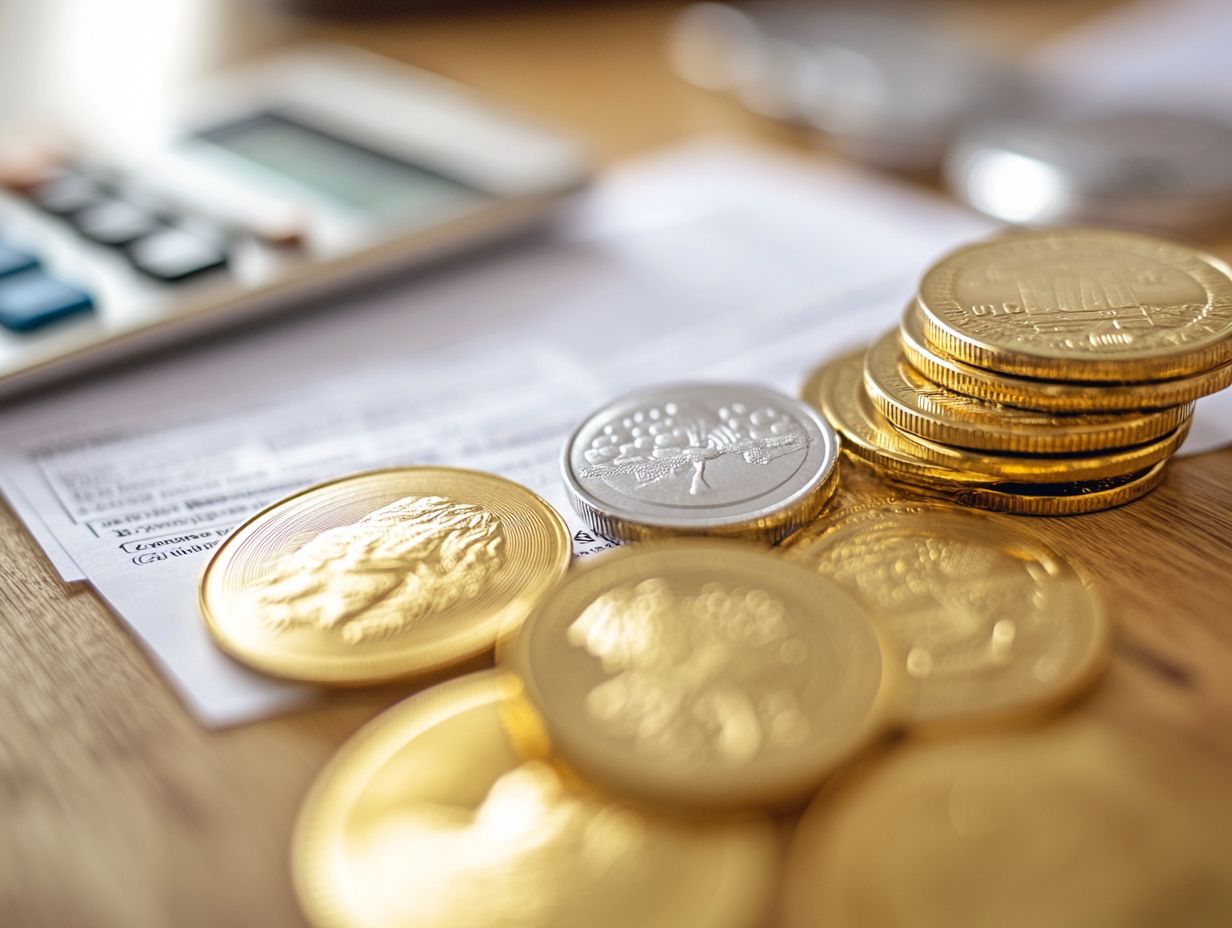
Tax-deferred growth means you can delay paying taxes on your investment gains while they grow. This approach boosts your returns, making investing more exciting! It also helps protect you from investment ups and downs, allowing for a more stable strategy in wealth accumulation.
In retirement accounts like gold IRAs and self-directed IRAs, this feature is crucial for smart retirement planning. For instance, with a gold IRA, you can set aside some of your contributions to physical gold, which acts as a hedge against inflation and market downturns. Understanding the role of precious metals in tax-deferred accounts can enhance your strategy. Self-directed IRAs let you diversify your investments, giving you the freedom to choose assets that align perfectly with your financial goals.
By postponing taxes, you can enjoy compounded growth over the years, significantly amplifying your retirement savings and paving the way for a more secure financial future.
Tax-Free Distributions
Tax-free distributions offer you an incredible advantage when using retirement accounts that accommodate precious metals, especially Roth IRAs. By structuring your investments wisely, you can withdraw funds without incurring taxes, optimizing your financial strategy and ensuring smoother transitions into retirement.
This aspect of Roth IRAs is particularly appealing, as it lets you contribute after-tax dollars. When it’s time to withdraw in retirement, you can do so tax-free, provided you meet specific conditions. For example, if you’ve held your Roth IRA for at least five years and are over the age of 59 , you can access both your contributions and earnings without any tax liabilities.
This can be especially beneficial if you plan to use these funds for major life events, like buying your first home or financing educational expenses, where traditional withdrawal penalties could apply. When you know how tax-free distributions work, you can effectively tailor your retirement plans and potentially boost your overall savings meaningfully.
How to Invest in Precious Metals in Retirement Accounts
Investing in precious metals within your retirement accounts needs careful planning to ensure compliance with IRS regulations while maximizing your gains.
You have several investment options available, including gold, silver, and platinum coins. It s essential to consider factors like custodial and transaction fees associated with these investments while keeping your sights set on long-term wealth protection.
Options for Investing in Precious Metals
When exploring ways to invest in precious metals, two great options are available: American Eagle coins and Canadian Maple Leaf coins. These widely recognized physical assets serve not just as currency but also as valuable investments, offering you the chance to diversify your portfolio and hedge against inflation.
You might also think about gold and silver bullion bars, which come in various weights and purities, catering to those interested in larger investments. Additionally, platinum and palladium are gaining popularity in the market, providing alternative paths for wealth preservation.
Historically, these precious metals have shown strong performance during economic downturns, often acting as a refuge for investors seeking stability.
The intrinsic value and limited supply of these metals enhance their appeal, making them an essential part of a well-rounded investment strategy.
Factors to Consider when Investing
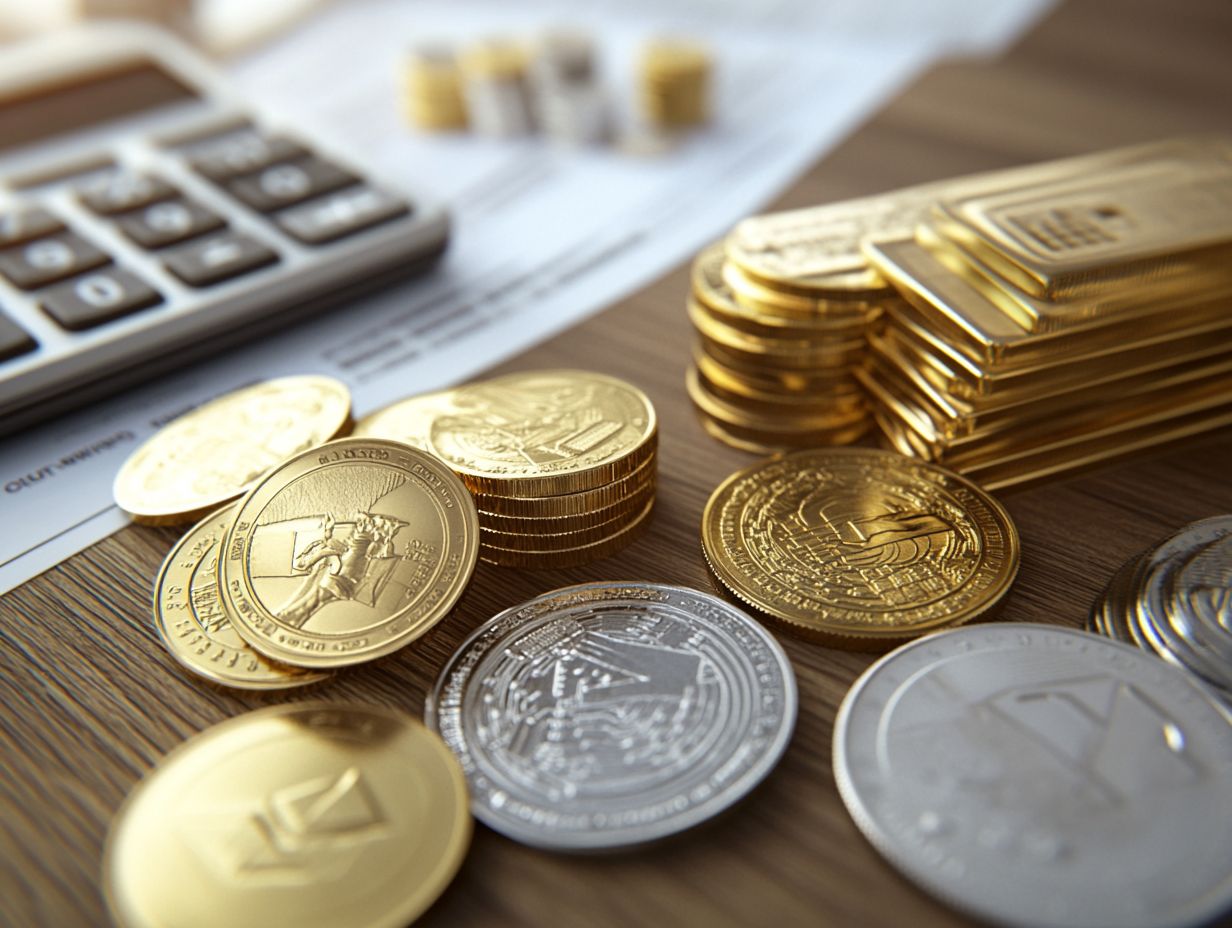
Before diving into precious metals investing, weigh key factors for a successful strategy. Understand the fees charged for keeping your investments safe and be aware of potential market drops.
Evaluate your personal investment goals, as these will guide the type and allocation of metals to consider whether gold, silver, or other alternatives. Stay informed about trends and global financial indicators that influence pricing fluctuations.
By balancing these considerations, you can make sound decisions and implement robust risk management strategies. This approach ensures your investments align with broader financial objectives while safeguarding against the unpredictability of the precious metals market.
Risks and Considerations
Investing in precious metals involves unique risks. Volatility and economic uncertainty can impact your investment strategy and outcomes.
Factors like required minimum distributions can add complexity to your decision-making process. Embrace a well-rounded approach to wealth management to ensure your choices align with your overall financial goals.
Potential Risks and How to Mitigate Them
Recognizing the potential risks involved with precious metals is important. You may encounter significant volatility and shifts in economic stability, both of which can affect asset values.
Prices of gold, silver, and platinum can fluctuate based on geopolitical tensions, currency values, and interest rates. Historical events like the 2008 financial crisis remind us how market downturns can suddenly drop precious metal prices.
To navigate these unpredictable waters, explore effective strategies for risk mitigation. Consider maintaining a diverse portfolio that includes precious metals, stocks, and bonds.
Staying updated with market analysis can provide insights into trends and shifts. This proactive strategy enhances your resilience against market turbulence.
Factors to Consider Before Investing in Precious Metals
Before plunging into precious metal investments, evaluate several factors that could shape your retirement plan and overall financial strategy. Take into account investment volatility and your personal financial goals.
Understanding how precious metals fit into your broader financial framework can enhance your strategy. Acknowledge how market fluctuations influence these assets to set realistic investment goals that match your risk tolerance.
Contemplate how these investments might be affected by major financial events, like job changes or market downturns. A comprehensive evaluation of your cash flow needs during retirement can help determine optimal metal allocation within a diversified portfolio.
Frequently Asked Questions
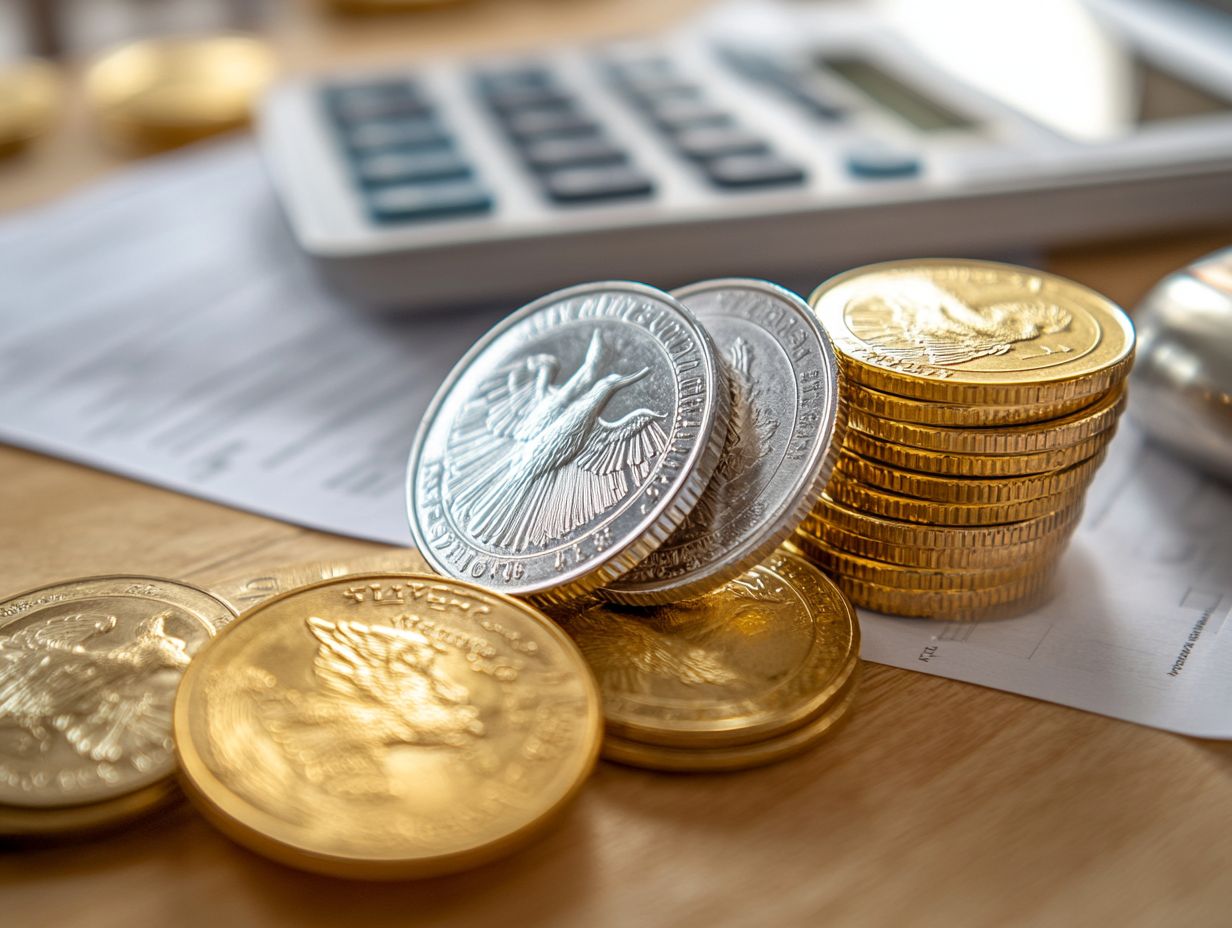
Don’t miss this essential information! Explore your investment options now!
What are the tax benefits of investing in precious metals within a retirement account?
Investing in precious metals, like gold and silver, in a retirement account can offer great tax advantages. You can enjoy tax-deferred growth and possibly lower capital gains taxes compared to traditional investments.
Are there any restrictions on investing in precious metals in retirement accounts?
Yes, restrictions and guidelines exist for investing in precious metals within retirement accounts. These include the types of accounts and precious metals permitted.
Can I rollover funds from my current retirement account into a precious metals IRA?
Absolutely! You can rollover funds from a traditional IRA, 401(k), or other eligible retirement accounts into a precious metals IRA without facing taxes or penalties.
Do I have to pay taxes when I withdraw precious metals from my retirement account?
Yes, you will need to pay taxes on your withdrawals, just like any other retirement account. If you wait until retirement age, you might fall into a lower tax bracket, which could reduce your tax bill.
Are there any risks associated with investing in precious metals within a retirement account?
Like any investment, there are risks when investing in precious metals within a retirement account. Market prices can fluctuate, so it s crucial to research and diversify your investment portfolio carefully.
What are the options for holding precious metals in a retirement account?
There are two main ways to hold precious metals in a retirement account: physically owning the metals or investing in a precious metals ETF. Each option has its benefits, so consult a financial advisor to find the best fit for your retirement goals.










